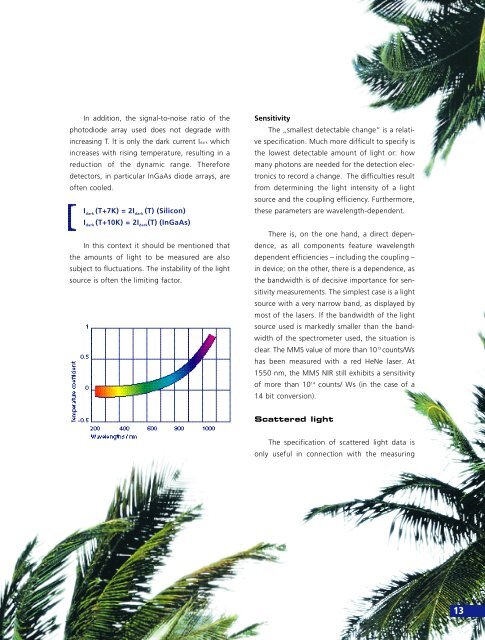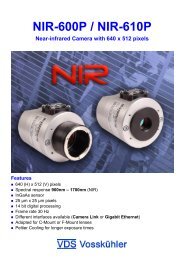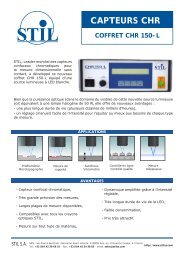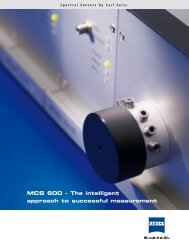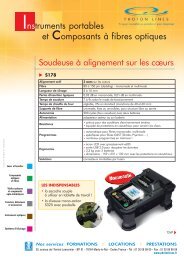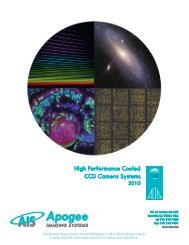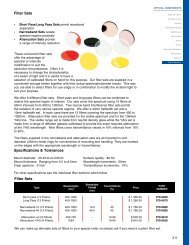MMS â Monolithic M i n i a t u re - S p e c t ro m e t e r - Photon Lines
MMS â Monolithic M i n i a t u re - S p e c t ro m e t e r - Photon Lines
MMS â Monolithic M i n i a t u re - S p e c t ro m e t e r - Photon Lines
Create successful ePaper yourself
Turn your PDF publications into a flip-book with our unique Google optimized e-Paper software.
In addition, the signal-to-noise ratio of thephotodiode array used does not degrade withi n c <st<strong>ro</strong>ng>re</st<strong>ro</strong>ng>asing T. lt is only the dark cur<st<strong>ro</strong>ng>re</st<strong>ro</strong>ng> n t Id a r k w h i c hi n c <st<strong>ro</strong>ng>re</st<strong>ro</strong>ng>ases with rising temperatu<st<strong>ro</strong>ng>re</st<strong>ro</strong>ng>, <st<strong>ro</strong>ng>re</st<strong>ro</strong>ng>sulting in a<st<strong>ro</strong>ng>re</st<strong>ro</strong>ng>duction of the dynamic range. The<st<strong>ro</strong>ng>re</st<strong>ro</strong>ng> f o <st<strong>ro</strong>ng>re</st<strong>ro</strong>ng>detectors, in particular InGaAs diode arrays, a<st<strong>ro</strong>ng>re</st<strong>ro</strong>ng>often cooled.I d a r k(T+7K) = 2I d a r k(T) (Silicon)I d a r k (T+10K) = 2I d a r k (T) (InGaAs)In this context it should be mentioned thatthe amounts of light to be measu<st<strong>ro</strong>ng>re</st<strong>ro</strong>ng>d a<st<strong>ro</strong>ng>re</st<strong>ro</strong>ng> alsosubject to fluctuations. The instability of the lights o u rce is often the limiting factor.SensitivityThe „smallest detectable change“ is a <st<strong>ro</strong>ng>re</st<strong>ro</strong>ng> l a t i-ve specification. Much mo<st<strong>ro</strong>ng>re</st<strong>ro</strong>ng> difficult to specify isthe lowest detectable amount of light or: howmany photons a<st<strong>ro</strong>ng>re</st<strong>ro</strong>ng> needed for the detection elect<strong>ro</strong>nics to <st<strong>ro</strong>ng>re</st<strong>ro</strong>ng> c o rd a change. The difficulties <st<strong>ro</strong>ng>re</st<strong>ro</strong>ng> s u l tf <strong>ro</strong>m determining the light intensity of a lights o u rce and the coupling eff i c i e n c y. Furt h e rm o <st<strong>ro</strong>ng>re</st<strong>ro</strong>ng> ,these parameters a<st<strong>ro</strong>ng>re</st<strong>ro</strong>ng> wavelength-dependent.T h e <st<strong>ro</strong>ng>re</st<strong>ro</strong>ng> is, on the one hand, a di<st<strong>ro</strong>ng>re</st<strong>ro</strong>ng>ct dependence,as all components featu<st<strong>ro</strong>ng>re</st<strong>ro</strong>ng> wavelengthdependent efficiencies – including the coupling –in device; on the other, the<st<strong>ro</strong>ng>re</st<strong>ro</strong>ng> is a dependence, asthe bandwidth is of decisive importance for sensitivitymeasu<st<strong>ro</strong>ng>re</st<strong>ro</strong>ng>ments. The simplest case is a lights o u rce with a very nar<strong>ro</strong>w band, as displayed bymost of the lasers. lf the bandwidth of the lights o u rce used is markedly smaller than the bandwidthof the spect<strong>ro</strong>meter used, the situation isc l e a r. The <st<strong>ro</strong>ng>MMS</st<strong>ro</strong>ng> value of mo<st<strong>ro</strong>ng>re</st<strong>ro</strong>ng> than 10 13 c o u n t s / W shas been measu<st<strong>ro</strong>ng>re</st<strong>ro</strong>ng>d with a <st<strong>ro</strong>ng>re</st<strong>ro</strong>ng>d HeNe laser. At1550 nm, the <st<strong>ro</strong>ng>MMS</st<strong>ro</strong>ng> NIR still exhibits a sensitivityof mo<st<strong>ro</strong>ng>re</st<strong>ro</strong>ng> than 10 14counts/ Ws (in the case of a14 bit conversion).S c a t t e <st<strong>ro</strong>ng>re</st<strong>ro</strong>ng>d lightThe specification of scatte<st<strong>ro</strong>ng>re</st<strong>ro</strong>ng>d light data isonly useful in connection with the measuring13


